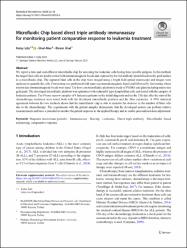| dc.contributor.author | Icoz, Kutay | |
| dc.contributor.author | Akar, Unal | |
| dc.contributor.author | Unal, Ekrem | |
| dc.date.accessioned | 2021-01-27T09:41:08Z | |
| dc.date.available | 2021-01-27T09:41:08Z | |
| dc.date.issued | 2020 | en_US |
| dc.identifier.issn | 1387-2176 | |
| dc.identifier.issn | 1572-8781 | |
| dc.identifier.other | PubMed ID: 32661698 | |
| dc.identifier.uri | https://doi.org/10.1007/s10544-020-00503-6 | |
| dc.identifier.uri | https://hdl.handle.net/20.500.12573/506 | |
| dc.description | Authors acknowledge TUBITAK (Project No: 115E020) for financial support. Authors also give thanks to Nazendenur Aksit and Ahsen Aydin for helping on taking the SEM images, Dr. Cengiz Gazeloglu from Isparta Suleyman Demirel University for valuable discussions on statistical analysis. | en_US |
| dc.description.abstract | We report a time and cost-efficient microfluidic chip for screening the leukemia cells having three specific antigens. In this method, the target blast cells are double sorted with immunomagnetic beads and captured by the 3rd antibody immobilized on the gold surface in a microfluidic chip. The captured blast cells in the chip were imaged using a bright-field optical microscope and images were analyzed to quantify the cells. First sorting was performed with nano size immunomagnetic beads and followed by 2nd sorting where micron size immunomagnetic beads were used. The low-cost microfluidic platform is made of PMMA and glass including micro size gold pads. The developed microfluidic platform was optimized with cultured B type lymphoblast cells and tested with the samples of leukemia patients. The 8 bone marrow samples of 4 leukemia patients on the initial diagnosis and on the 15th day after the start of the chemotherapy treatment were tested both with the developed microfluidic platform and the flow cytometry. A 99% statistical agreement between the two methods shows that the microfluidic chip is able to monitor the decrease in the number of blast cells due to the chemotherapy. The experiments with the patient samples demonstrate that the developed system can perform relative measurements and have a potential to monitor the patient response to the applied therapy and to enable personalized dose adjustment. | en_US |
| dc.description.sponsorship | Turkiye Bilimsel ve Teknolojik Arastirma Kurumu (TUBITAK)
115E020 | en_US |
| dc.language.iso | eng | en_US |
| dc.publisher | SPRINGER, VAN GODEWIJCKSTRAAT 30, 3311 GZ DORDRECHT, NETHERLANDS | en_US |
| dc.relation.isversionof | 10.1007/s10544-020-00503-6 | en_US |
| dc.rights | info:eu-repo/semantics/openAccess | en_US |
| dc.subject | comparative response | en_US |
| dc.subject | Microfluidic -based monitoring | en_US |
| dc.subject | Direct triple antibody | en_US |
| dc.subject | Leukemia | en_US |
| dc.subject | Biochip | en_US |
| dc.subject | Immunoassay | en_US |
| dc.subject | nano particles | en_US |
| dc.subject | Magnetic micro | en_US |
| dc.title | Microfluidic Chip based direct triple antibody immunoassay for monitoring patient comparative response to leukemia treatment | en_US |
| dc.type | article | en_US |
| dc.contributor.department | AGÜ, Mühendislik Fakültesi, Elektrik - Elektronik Mühendisliği Bölümü | en_US |
| dc.contributor.authorID | 0000-0002-0947-6166 | en_US |
| dc.contributor.authorID | 0000-0002-0000-8999 | en_US |
| dc.identifier.volume | Volume: 22 | en_US |
| dc.identifier.issue | 3 | en_US |
| dc.relation.journal | BIOMEDICAL MICRODEVICES | en_US |
| dc.relation.tubitak | 115E020 | |
| dc.relation.publicationcategory | Makale - Uluslararası - Editör Denetimli Dergi | en_US |


















